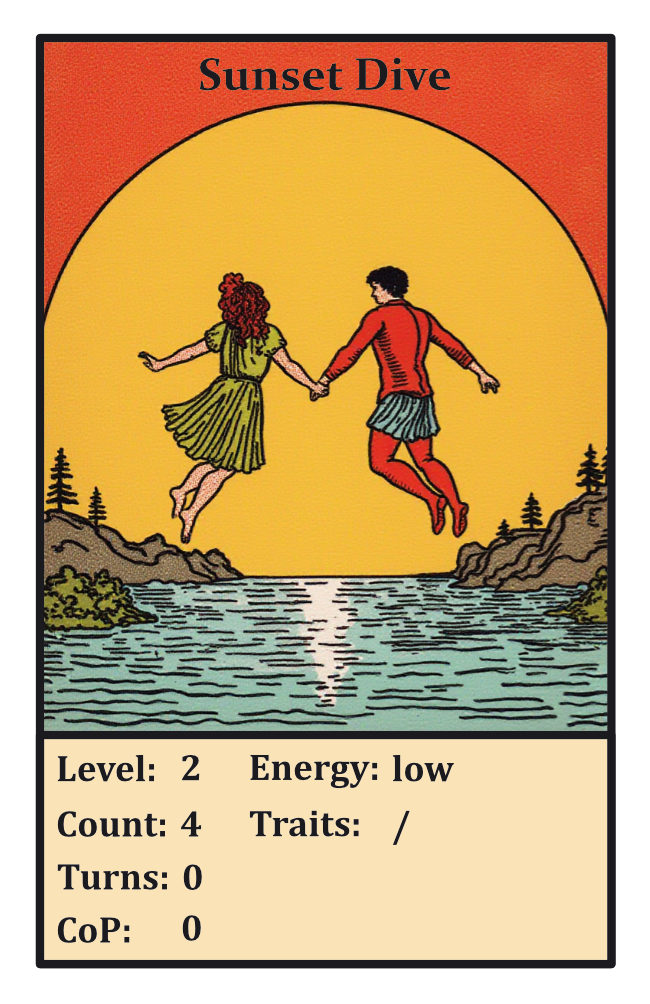Modern Jive Quartet
Each card in the game represents a Modern Jive move, named based on the Jive.Berlin syllabus. Cards contain up to six attributes, detailing the move as follows:
- Level: Moves are categorized into five levels:
- Level 1: Beginner moves, typically taught in your first Modern Jive class.
- Level 2: Moves that may require more practice.
- Level 3: Intermediate moves, requiring knowledge of techniques like drops, hammer locks, or spins.
- Level 4: Advanced moves.
- Level 5: Open-level moves, including aerials or those requiring special techniques or training.
- Count: The count starts from the first rock step* on count one. Only full beats are counted, excluding the „and beat.“
- *Note: A rock step can be a basic step back or a sideways step into a Wurlitzer position.
- Turns: A full turn is considered 360° for one partner in one continuous motion. Two 180° turns with a step back in between do not count as a full turn. Leader and follower turns are added together.
- Change of Place: This indicates that both partners switch positions, fully passing each other. Ending up side-by-side does not count.
- Energy: This reflects the minimum energy required for the move to work. For example:
- Energy 1: Basic engagement.
- Energy 2: Requires a stronger connection.
- Energy 3: Involves hammer techniques or a very strong connection.
- Trait: Additional information or characteristics about the move, such as specific techniques or elements.
Each card in the game represents a Modern Jive move, named based on the Jive.Berlin syllabus. Cards contain up to six attributes, detailing the move as follows:
- Level: Moves are categorized into five levels:
- Level 1: Beginner moves, typically taught in your first Modern Jive class.
- Level 2: Moves that may require more practice.
- Level 3: Intermediate moves, requiring knowledge of techniques like drops, hammer locks, or spins.
- Level 4: Advanced moves.
- Level 5: Open-level moves, including aerials or those requiring special techniques or training.
- Count: The count starts from the first rock step* on count one. Only full beats are counted, excluding the „and beat.“
- *Note: A rock step can be a basic step back or a sideways step into a Wurlitzer position.
- Turns: A full turn is considered 360° for one partner in one continuous motion. Two 180° turns with a step back in between do not count as a full turn. Leader and follower turns are added together.
- Change of Place: This indicates that both partners switch positions, fully passing each other. Ending up side-by-side does not count.
- Energy: This reflects the minimum energy required for the move to work. For example:
- Energy 1: Basic engagement.
- Energy 2: Requires a stronger connection.
- Energy 3: Involves hammer techniques or a very strong connection.
- Trait: Additional information or characteristics about the move, such as specific techniques or elements.
How to Play: Basic Trump Quartet
Players compete by comparing a selected attribute from their top card. The player with the higher value wins.
- Shuffle and deal the cards evenly. If the total number isn’t divisible, remove extra cards to balance the decks.
- Players only view the top card of their pile.
- The player to the dealer’s left starts by selecting an attribute and challenging another player: „Player 1 to Player 2: ‚Count 7‘.“ Player 2 responds with their value: „Count 2.“
- The higher value wins. The winner takes the opponent’s card and places it at the bottom of their pile.
- A player with no cards left loses, and the one with the most cards wins.
In case of a tie: Both players draw a new card. The challenged player selects a new attribute, and the comparison continues until one player wins the round and takes all the used cards.
In case of a tie: Both players draw a new card. The challenged player selects a new attribute, and the comparison continues until one player wins the round and takes all the used cards.
Game Variations
Demo Every Move:
After winning a duel, the player must demonstrate the move to claim the cards. If the demo is incorrect, each player keeps their own card, and the round continues.
Combining Moves:
Players draw the top three cards from their stack. When challenged, they can play one card or combine two or three moves. In this case, the values for the selected attribute are added together. Only valid combinations, where the last rock step of one move transitions smoothly into the next, are allowed. Handholds must also be continuous.
After playing their cards, players must demonstrate their routine. If a player cannot perform the combination or the routine is invalid, the opponent wins all the cards. If neither player succeeds, both lose their cards for that round.
After each duel, players draw new cards until they have three in hand.




